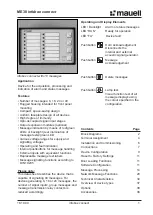
The Constant Fraction Discriminators CFD8c, CFD7x, CFD4c, CFD1c and CFD1x (11.0.1701.1)
Page 13 of 25
Higher
CFD fraction
(up to 0.8) is recommended for multi-hit operation, especially if the input signals show overshoot or
ringing patterns: The timing of later signals in the “ringing noise” from an earlier signal will be less affected if a high
CFD fraction
is chosen.
Figure 3.11b: Signal traces (as in Figure 3.8b left) with different CFD fractions: left picture f = 0.35, right: f = 0.7
3b.3.4
Walk level
For optimal timing resolution the
Walk level
must be very near the baseline of the input signals which corresponds also to the
baseline of the bipolar signal from M
a
output. To achieve this, at first the Z-potentiometer should be tuned until about 0 V can
be measured at the corresponding test point. Now the digital walk monitor (M
d
) shows one distinct transition from “high” (-
0.2 V) to “low” (-0.1 V) during the bipolar signal’s crossover, while fluctuating almost equally between “high” and “low” states
before and long after the signal, due to electronic noise on the line (not visible in the pictures). If the
Walk level
is perfectly set
to the input signal’s baseline, the output signal from the digital monitor (M
d
) is as often in the “high” state as in the “low”
state. This can be judged from an equal intensity (“brightness”) of the trace before the main transition signal in the two
possible states (see Figure 3.12b, left picture). Usually, the relative brightness before and immediately after the timing
transition are not the same. This is due to signal reflections and ringing following the input signal. Therefore, the intensities
before or long after (> few hundred ns) the timing transition should be compared.
Figure 3.12b: Signal traces (as in Figure 3.8b left) with the walk level set to the baseline of the input signals
(left picture) and slightly towards the positive side where the noise triggers begin to vanish
(right picture), leading to slightly less intensity in the area right of the arrow.











































